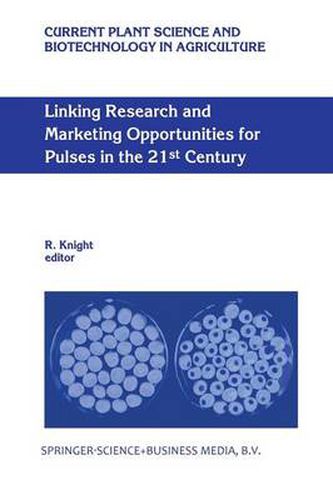Linking Research and Marketing Opportunities for Pulses in the 21st Century: Proceedings of the Third International Food Legumes Research Conference

Linking Research and Marketing Opportunities for Pulses in the 21st Century: Proceedings of the Third International Food Legumes Research Conference
This title is printed to order. This book may have been self-published. If so, we cannot guarantee the quality of the content. In the main most books will have gone through the editing process however some may not. We therefore suggest that you be aware of this before ordering this book. If in doubt check either the author or publisher’s details as we are unable to accept any returns unless they are faulty. Please contact us if you have any questions.
Food legumes (pulses) playa role in human nutrition and more recently as animal feed, in the developing world. They contain minerals and vitamins essential for a balanced diet in humans. In many developing countries food legumes provide the necessary protein and amino acids (in predominantly vegetarian India, Bangladesh, Nepal, Myanmar and Sri Lanka) and supplement the protein diet of people in other countries. Since 1980-82 per capita consumption has declined by 6 % in developing countries where relative pulse prices have gone up and consumption of animal protein (eg milk) has increased. The importance of legumes as animal feed is increasing. The compound growth rate for feed use during 1980-95 was 7. 97% compared to 1. 5% growth for food use during the same period (Kelly et aI. , 1997). As an integral part of farming systems, food legumes, in rotation with cereals and tuber crops, assist in maintaining soil fertility and the sustainability of production systems (Rego et aI. , 1996). Owing to higher prices in comparison with cereals, food legumes are increasingly being grown to supplement farmers’ incomes. The major food legumes grown in developing countries are: dry bean (Phaseolus vulgaris), faba bean (Vicia faba), dry pea (Pisum sativum), chickpea (Cicer arietinum), lentil (Lens culinaris), mung bean (Vigna radiata), black gram (Vigna mungo) pigeonpea (Cajanus cajan) and Lathyrns ( Lathyrus sativus). Oil crops such as groundnut (Arachis hypogaea) and soybean (Glycine max) are food legumes but are not discussed in this paper.
This item is not currently in-stock. It can be ordered online and is expected to ship in 7-14 days
Our stock data is updated periodically, and availability may change throughout the day for in-demand items. Please call the relevant shop for the most current stock information. Prices are subject to change without notice.
Sign in or become a Readings Member to add this title to a wishlist.


